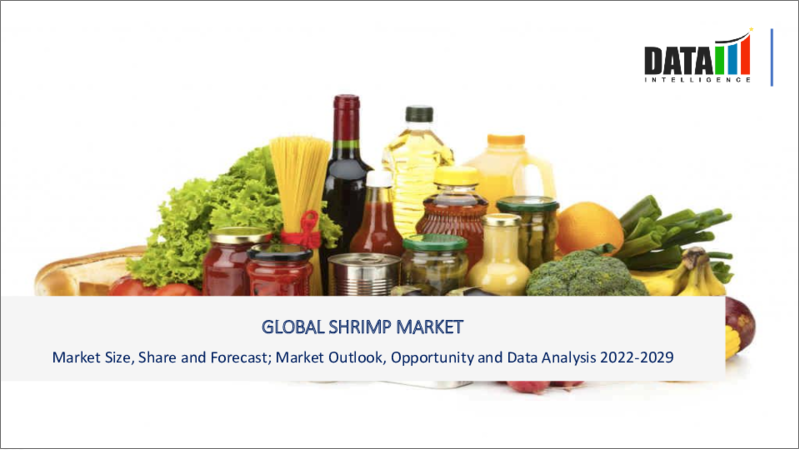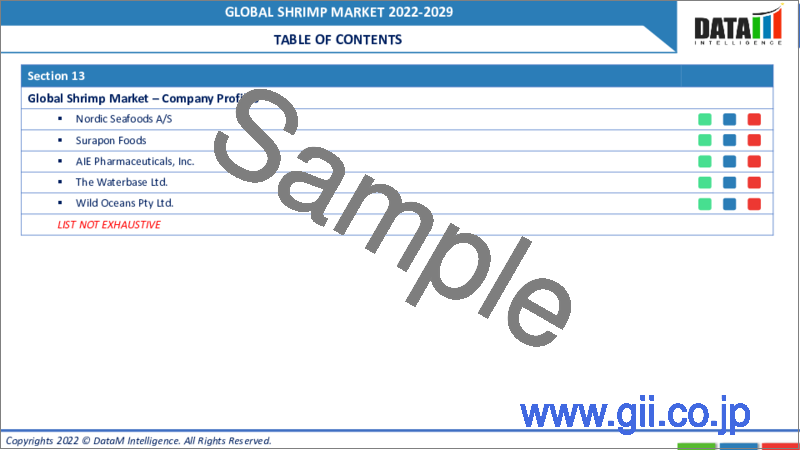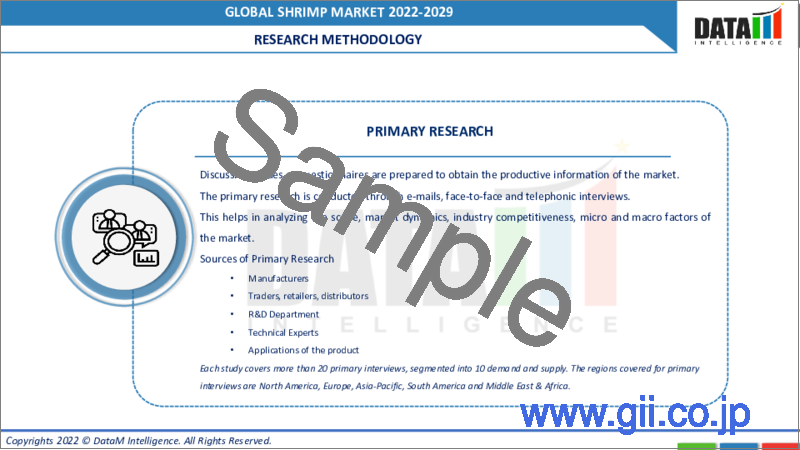|
|
市場調査レポート
商品コード
1133496
エビの世界市場-2022-2029Global Shrimp Market - 2022-2029 |
||||||
|
● お客様のご希望に応じて、既存データの加工や未掲載情報(例:国別セグメント)の追加などの対応が可能です。 詳細はお問い合わせください。 |
|||||||
| エビの世界市場-2022-2029 |
|
出版日: 2022年10月11日
発行: DataM Intelligence
ページ情報: 英文 170 Pages
納期: 約2営業日
|
- 全表示
- 概要
- 目次
市場力学
高タンパク食と持続可能な水産物の選択に対する需要の高まりが、市場の成長を促進する
タンパク質が豊富な食事に対する消費者の高い需要、処分所得の増加、栄養豊富な製品への支出の増加は、市場成長の原動力になると予想されます。また、メーカーは消費者のためにタンパク質が豊富な新製品の開発に注力しています。エビの消費に消費者を引き付けるタンパク質の豊富なソースです。さらに、さまざまな健康上の利点は、市場の成長を推進しています。エビは低カロリーです。また、9種類以上のビタミンとミネラルを含み、甲状腺機能と脳の健康に良いとされるヨウ素を豊富に含んでいます。また、脂肪酸も豊富に含まれており、健康増進に役立ちます。アスタキサンチンという抗酸化物質の一種を含んでいます。アスタキサンチンは、エビが摂取する藻類の成分です。この抗酸化物質は、エビの細胞に赤い色を与えます。この抗酸化物質は、慢性疾患のリスクと心臓発作のリスクを低減するのに役立ちます。また、高密度リポタンパク質または善玉コレステロールのレベルを増加させるのに役立つと考えられています。アスタキサンチンは、脳の健康にも良いとされています。その抗炎症特性は、脳細胞への損傷を防ぐ。
本レポートでは、エビの世界市場について、約77の市場データ表、71の図表、170ページにわたる情報を提供します。
目次
第1章 調査手法と範囲
- 調査手法
- 市場の範囲
第2章 主な動向と発展
第3章 エグゼクティブサマリー
- タイプ別市場内訳
- 形態別市場内訳
- エンドユーザー別市場内訳
- 地域別市場内訳
第4章 市場力学
- 市場影響要因
- 促進要因
- 抑制要因
- ビジネスチャンス
- 影響分析
第5章 産業分析
- ポーターのファイブフォース分析
- バリューチェーン分析
- 特許分析
- 規制分析
第6章 COVID-19の分析
- COVID-19の市場分析
- COVID-19以前の市場シナリオ
- COVID-19の現在の市場シナリオ
- COVID-19の後、または将来のシナリオ
- COVID-19の中での価格ダイナミクス
- 需要-供給スペクトラム
- パンデミック時の市場に関連する政府の取り組み
- メーカーの戦略的取り組み
第7章 タイプ別
- ピンク
- ブラウン
- 白色
- その他
第8章 形態別
- 冷凍
- 缶詰
第9章 エンドユーザー別
- 住宅用
- 業務用
第10章 流通チャネル別
- ハイパーマーケット・スーパーマーケット
- コンビニエンスストア
- オンライン販売チャネル
- その他
第11章 地域別
- 北米
- 米国
- カナダ
- メキシコ
- 南米
- ブラジル
- アルゼンチン
- その他の南米地域
- 欧州
- ドイツ
- 英国
- フランス
- スペイン
- イタリア
- その他の欧州地域
- アジア太平洋地域
- 中国
- インド
- 日本
- オーストラリア
- その他アジア太平洋地域
- 中東・アフリカ地域
第12章 競合情勢
- 競合シナリオ
- 競合他社の戦略分析
- 市況/シェア分析
- M&A(合併・買収)分析
第13章 企業プロファイル
- Medicamen Biotech Ltd.
- 企業概要
- 製品ポートフォリオと説明
- 主なハイライト
- 財務概要
- BASF SE
- Superior Supplement Manufacturing
- Gnosis SPA
- Seidler Chemical Co, Inc.
- Nutritional Supplement Manufacturers, Inc.
- Shandong Xinfa Pharmaceutical Co.
- AIE Pharmaceuticals, Inc.
- Hebei Jiheng Group Pharmacy Co Ltd.
- Niutang Chemical Plant Co. Ltd.
- List not Exhaustive
第14章 データエム
Market Overview
Shrimp Market was valued at USD XX million in 2021. It is forecasted to reach USD XX million by 2029, growing at a CAGR of XX% during the forecast period (2022-2029).
Shrimp is a small invertebrate found in all marine ecosystem. Shrimps are essential components of the marine food web. Larger shrimp species are sought by commercial fisheries for human consumption. Some shrimp species are raised in aquaculture in tropical areas. They are omnivorous animals, which consume a wide range of plant and animal species. Conversely, they are natural prey for a variety of predators due to their small size and abundance. The major factors and shrimp market trends that drive the growth of the shrimp market include easy availability of shrimps and their high nutritional content. As one of the most traded species of seafood, they are an essential components of various cuisines.
Market Dynamics: Rising demand for high protein diet and sustainable seafood choices to foster market growth
High consumer demand for the protein-rich diet, rising disposal income, and increasing expenditure on nutrient-rich products is expected to drive the market growth. Also, manufacturers are focused on developing new protein-rich products for consumers. Shrimps are the rich source of protein that attract consumers to the consumption of shrimps. Moreover, various health benefits drive the growth of market. Shrimp is low in calories. It provides more than 9 different vitamins and minerals and is a rich source of iodine, which is good for proper thyroid function and brain health. It is also rich source of fatty acid and a good health booster. It contains the primary type of antioxidant called astaxanthin. Astaxanthin is a component of algae, which shrimp consume. This antioxidant gives a red color to the cells of shrimp. This antioxidant helps to reduce the risk of chronic disease and the risk of a heart attack. It may also help increase levels of high-density lipoprotein or good cholesterol. Astaxanthin is good for brain health. Its anti-inflammatory properties prevent damage to brain cells.
Market Segmentation: Frozen shrimp segment accounted for the highest share in global shrimp market
In 2021, frozen shrimp had the highest revenue share of over XX percent. Fresh shrimps are available in a specific region and only for a specific season. On the other hand, frozen shrimps can be stored all year. They are easy to transport and handle. Frozen shrimp is available in different pack sizes and has many brand options to select from. Some major key players like Aqua Star, Avanti Feeds Ltd, Clearwater Seafood's, and High Liner Foods Inc, among others, sell frozen shrimps. High demand for frozen shrimp from hotels and restaurants tends to increase sales. However, frozen shrimp is more expensive than fresh due to its storage and packaging costs.
Moreover, white shrimp held the highest market share after frozen shrimp. White shrimp is a rich source of nutrients, and it can store them for a long time. White shrimp are crustaceans with relatively long walking legs and five pairs of swimming legs located on the front surface of the abdomen. They have a light gray body with green coloration on the tail and a yellow band on the part of the abdomen. According to NOAA Fisheries, in 2020, white shrimp totaled 110 million pounds and were valued at $254 million. White shrimp were the commercially important shrimp species in the United States.
Geographical Penetration: North America is the dominating region during the forecast period
In 2021, the North American region had the highest revenue share of almost XX percent. Increasing demand for white shrimp in the region drives the growth of the market. The US imports 75% and 80% of the seafood from other countries, like Thailand, China, Canada, Indonesia, and Vietnam. Shrimp farming in the USA is the largest form of aquaculture business consuming various species of prawns and marine shrimp. The US is the second-largest consumer of shrimp after China. Shrimps are the most eaten food in the US, accounting for 25%-30% of the total seafood market in the country. The states of Hawaii, South Carolina, Kentucky and Florida have the highest surface acreage for prawn production. Also, the US government supports aquaculture producers. In the last few years, per capita consumption of meat has declined due to the changes in consumer food preference and increased health awareness; as a result, the country's popularity of seafood products such as shrimp increased.
Competitive Landscape:
There are several established participants in the industry and local manufacturers; hence, the market is fragmented. Some major market players are Aqua Star, Avanti Feeds Ltd., Clearwater Seafoods, High Liner Foods Inc, Mazzetta Company, LLC, and Nordic Seafood A/S. Some of the major key players follows merger and collaboration strategies for the company's growth. For instance, in March 2018, Aqua Star acquired an equity stake in an Indian shrimp producer. Sagar Grandhi produces about 150,000 tons of shrimp annually, with farms and contract farmers using 10,000 hectares in Chittedu, which is in the Nellore district of Andhra Pradesh. Also, in February 2019, Cooke Inc completed its acquisition of the business of the Seajoy Seafood Corporation group, which is one of the largest vertically integrated premium shrimp farms in Latin America. This acquisition's main focus is product diversification to meet consumers needs. In March 2020, Sykes completed the deal for shrimp processor Klass puul Beheer by creating $300 m shrimps. The combination of these two businesses offered customers access to a wide range of products in frozen format for retail and food service.
COVID-19 Impact: Negative impact on the global shrimp market
The outbreak of COVID-19 has a significant impact on the food service industry. The Asia Pacific is one of the leading producers of shrimp. However, decapod crustaceans production in the region was delayed by 3 months in the year 2020 due to the COVID-19 crisis. The decrease in demand from Asian countries like China, Vietnam, and India may negatively affect the market's growth. All the business dropped by 80-90%. Sales of seafood like shrimp have decreased due to the strict lockdowns and curfews worldwide. Lockdown across all major regions has led to travel restrictions which have serious effect on the distribution channel. The global production of shrimp is decreased in the year 2020, with global demand for fresh and frozen shrimp decreased significantly. Furthermore, the import and export of shrimp are completely closed during a pandemic. Also, hotels and restaurants are completely closed during the pandemic, which is the major reason for the decrease in shrimp sales in the global market.
The global shrimp market report would provide an access to approximately 77 market data tables, 71 figures and 170 pages
Table of Contents
Scope and Methodology
- 1.1. Research Methodology
- 1.2. Scope of the Market
2. Key Trends and Developments
3. Executive Summary
- 3.1. Market Snippet by Type
- 3.2. Market Snippet by Form
- 3.3. Market Snippet by End User
- 3.4. Market Snippet by Region
4. Market Dynamics
- 4.1. Market impacting factors
- 4.1.1. Drivers
- 4.1.2. Restraints
- 4.1.3. Opportunities
- 4.2. Impact analysis
5. Industry Analysis
- 5.1. Porter's five forces analysis
- 5.2. Value chain analysis
- 5.3. Patent Analysis
- 5.4. Regulatory Analysis
6. COVID-19 Analysis
- 6.1. Analysis of Covid-19 on the Market
- 6.1.1. Before COVID-19 Market Scenario
- 6.1.2. Present COVID-19 Market Scenario
- 6.1.3. After COVID-19 or Future Scenario
- 6.2. Pricing Dynamics Amid Covid-19
- 6.3. Demand-Supply Spectrum
- 6.4. Government Initiatives Related to the Market During Pandemic
- 6.5. Manufacturers Strategic Initiatives
7. By Type
- 7.1. Introduction
- 7.1.1. Market size analysis, and y-o-y growth analysis (%), By Type Segment
- 7.1.2. Market attractiveness index, By Type Segment
- 7.2. Pink*
- 7.2.1. Introduction
- 7.2.2. Market Size Analysis, US$ Million, 2020-2029 And Y-O-Y Growth Analysis (%), 2021-2029
- 7.3. Brown
- 7.4. White
- 7.5. Others
8. By Form
- 8.1. Introduction
- 8.1.1. Market size analysis, and y-o-y growth analysis (%), By Form Segment
- 8.1.2. Market attractiveness index, By Form Segment
- 8.2. Frozen *
- 8.2.1. Introduction
- 8.2.2. Market Size Analysis, US$ Million, 2020-2029 And Y-O-Y Growth Analysis (%), 2021-2029
- 8.3. Canned
9. By End User
- 9.1. Introduction
- 9.1.1. Market size analysis, and y-o-y growth analysis (%), By End User Segment
- 9.1.2. Market attractiveness index, By End User Segment
- 9.2. Residential*
- 9.2.1. Introduction
- 9.2.2. Market Size Analysis, US$ Million, 2020-2029 And Y-O-Y Growth Analysis (%), 2021-2029
- 9.3. Commercial
10. By Distribution Channel
- 10.1. Introduction
- 10.1.1. Market size analysis, and y-o-y growth analysis (%), By Distribution Channel Segment
- 10.1.2. Market attractiveness index, By Distribution Channel Segment
- 10.2. Hypermarkets & Supermarkets*
- 10.2.1. Introduction
- 10.2.2. Market Size Analysis, US$ Million, 2020-2029 And Y-O-Y Growth Analysis (%), 2021-2029
- 10.3. Convenience Stores
- 10.4. Online Sales Channel
- 10.5. Others
11. By Region
- 11.1. Introduction
- 11.1.1. Market Size Analysis, And Y-O-Y Growth Analysis (%), By Region
- 11.1.2. Market Attractiveness Index, By Region
- 11.2. North America
- 11.2.1. Introduction
- 11.2.2. Key region-specific dynamics
- 11.2.3. Market Size Analysis, And Y-O-Y Growth Analysis (%), By Type
- 11.2.4. Market Size Analysis, And Y-O-Y Growth Analysis (%), By Form
- 11.2.5. Market Size Analysis, And Y-O-Y Growth Analysis (%), By End User
- 11.2.6. Market Size Analysis, And Y-O-Y Growth Analysis (%), By Distribution Channel
- 11.2.7. Market Size Analysis, And Y-O-Y Growth Analysis (%), By Country
- 11.2.7.1. U.S.
- 11.2.7.2. Canada
- 11.2.7.3. Mexico
- 11.3. South America
- 11.3.1. Introduction
- 11.3.2. Key Region-Specific Dynamics
- 11.3.3. Market Size Analysis, And Y-O-Y Growth Analysis (%), By Type
- 11.3.4. Market Size Analysis, And Y-O-Y Growth Analysis (%), By Form
- 11.3.5. Market Size Analysis, And Y-O-Y Growth Analysis (%), By End User
- 11.3.6. Market Size Analysis, And Y-O-Y Growth Analysis (%), By Distribution Channel
- 11.3.7. Market Size Analysis, And Y-O-Y Growth Analysis (%), By Country
- 11.3.7.1. Brazil
- 11.3.7.2. Argentina
- 11.3.7.3. Rest of South America
- 11.4. Europe
- 11.4.1. Introduction
- 11.4.2. Key Region-Specific Dynamics
- 11.4.3. Market Size Analysis, And Y-O-Y Growth Analysis (%), By Type
- 11.4.4. Market Size Analysis, And Y-O-Y Growth Analysis (%), By Form
- 11.4.5. Market Size Analysis, And Y-O-Y Growth Analysis (%), By End User
- 11.4.6. Market Size Analysis, And Y-O-Y Growth Analysis (%), By Distribution Channel
- 11.4.7. Market Size Analysis, And Y-O-Y Growth Analysis (%), By Country
- 11.4.7.1. Germany
- 11.4.7.2. U.K.
- 11.4.7.3. France
- 11.4.7.4. Spain
- 11.4.7.5. Italy
- 11.4.7.6. Rest of Europe
- 11.5. Asia Pacific
- 11.5.1. Introduction
- 11.5.2. Key Region-Specific Dynamics
- 11.5.3. Market Size Analysis, And Y-O-Y Growth Analysis (%), By Type
- 11.5.4. Market Size Analysis, And Y-O-Y Growth Analysis (%), By Form
- 11.5.5. Market Size Analysis, And Y-O-Y Growth Analysis (%), By End User
- 11.5.6. Market Size Analysis, And Y-O-Y Growth Analysis (%), By Distribution Channel
- 11.5.7. Market Size Analysis, And Y-O-Y Growth Analysis (%), By Country
- 11.5.7.1. China
- 11.5.7.2. India
- 11.5.7.3. Japan
- 11.5.7.4. Australia
- 11.5.7.5. Rest of Asia Pacific
- 11.6. Middle East and Africa
- 11.6.1. Introduction
- 11.6.2. Key Region-Specific Dynamics
- 11.6.3. Market Size Analysis, And Y-O-Y Growth Analysis (%), By Type
- 11.6.4. Market Size Analysis, And Y-O-Y Growth Analysis (%), By Form
- 11.6.5. Market Size Analysis, And Y-O-Y Growth Analysis (%), By End User
- 11.6.6. Market Size Analysis, And Y-O-Y Growth Analysis (%), By Distribution Channel
12. Competitive Landscape
- 12.1. Competitive scenario
- 12.2. Competitor strategy analysis
- 12.3. Market positioning/share analysis
- 12.4. Mergers and acquisitions analysis
13. Company Profiles
- 13.1. Medicamen Biotech Ltd.*
- 13.1.1. Company Overview
- 13.1.2. Product Portfolio and Description
- 13.1.3. Key Highlights
- 13.1.4. Financial Overview
- 13.2. BASF SE
- 13.3. Superior Supplement Manufacturing
- 13.4. Gnosis SPA
- 13.5. Seidler Chemical Co, Inc.
- 13.6. Nutritional Supplement Manufacturers, Inc.
- 13.7. Shandong Xinfa Pharmaceutical Co.
- 13.8. AIE Pharmaceuticals, Inc.
- 13.9. Hebei Jiheng Group Pharmacy Co Ltd.
- 13.10. Niutang Chemical Plant Co. Ltd.
- List not Exhaustive*
14. DataM
- 14.1. Appendix
- 14.2. About us and services
- 14.3. Contact us




